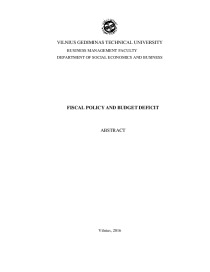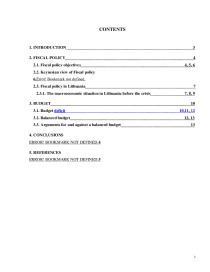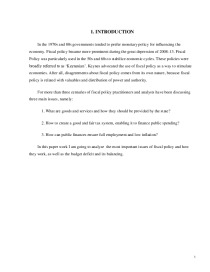Fiscal Policy And Budget Deficit



Introduction. Fiscal policy. Fiscal policy objectives. Keynesian view of Fiscal policy 6. Budget. Conclusions. References.
For more than three centuries of fiscal policy practitioners and analysts have been discussing three main issues, namely:
2. How to create a good and fair tax system, enabling it to finance public spending?
3. How can public finances ensure full employment and low inflation?
In this paper work I am going to analyze the most important issues of fiscal policy and how they work, as well as the budget deficit and its balancing.
Following topics are the main objectives of a fiscal policy in a developing economy:
At present, Lithuania still is at economic recession stage. In 2004 Lithuania joined the EU, and was one of the fastest country, witch legalized EU laws. Lithuania applied for fiscal policy. However, in 2009 Lithuania experienced a crisis, and the government started to run strict anti-crisis fiscal policy.
Graph 3 Lithuania's total export and imports 2005-2011 (EUR billions)
Talking about my country, Lithuania, state budget is drawn up by the Lithuanian Ministry of Finance. Offering for the necessary funds, it is guided by other ministries and institutions operating plans, which are prepared according to government programs, its strategic objectives and implement them in practice. Drafting the budget last year and completed by the fall of the Government and the Parliament , where the budget is approved. Later, the President signed by the Republic of Lithuania and Municipal Budgets Financial Indicators of the law.
According to the graph 5, in 2015 Lithuania has 1,659 mln. eur. deficit. In 2016 government is planning to reduce deficit more than twice, to 640 mln. eur. Further projects are similar like in 2016, to reach 583 mln. eur. deficit in 2017, and about 506 mln. eur. In 2018.
Graph 5 Prospective income, expenses and deficit of Lithuania, mln. eur.
This paper work is primarily meant to find the main aspects of fiscal policy and budget. Fiscal policy changes when the government changes its spending programs or tax rate. When taxes are reduced, people have more net income, which encourages personal savings. However, increased savings not necessarily increase investments. The problem is that tax cuts are pushing the government into a higher budget deficit and it forces government to borrow. Borrowing takes people's savings and people do not invest in the end. In other words, the population’s savings counterbalances the government’s budget deficit. This is the main relation between the government‘s fiscal policy and budget deficit.
- Economy & Finance Papers
- Microsoft Word 662 KB
- 2018 m.
- English
- 15 pages (2463 words)
- University
- Vilma

















